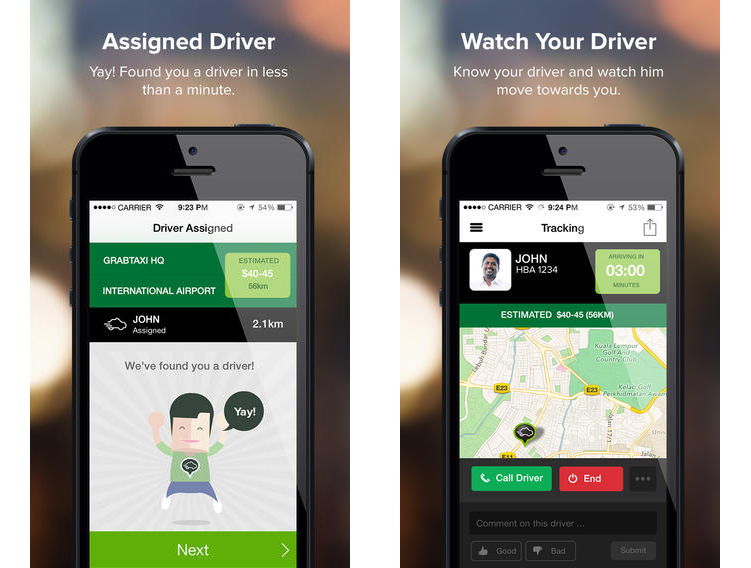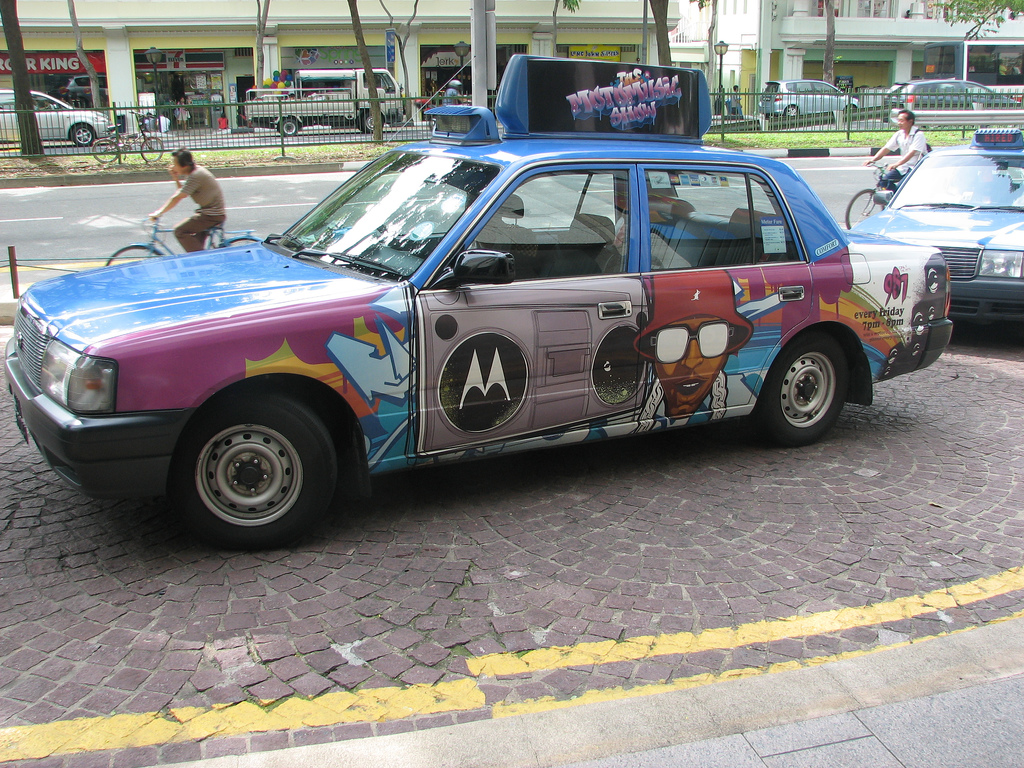Why GrabTaxi is giving Singapore’s largest taxi operator a run for its money
Hawyee is a research associate at the Lee Kuan Yew School of Public Policy in Singapore. Opinions expressed here are his own.

Friday was the first time I used the taxi booking app GrabTaxi to book a cab. I had a lunch appointment to go to and it had just started raining. None of the official apps from the taxi companies – Comfort, Trans-Cab, and SMRT – were successful in getting me a cab. The third try with GrabTaxi was successful. The cab arrived in a minute. On the way to lunch, I asked the driver about his experience with GrabTaxi and here’s what I found out.
GrabTaxi has a rapidly growing number of cab drivers using its app
Comfort, Singapore’s largest taxi company, has around 16,600 cabs plying the road. GrabTaxi has 10,000 registered drivers now in the country, making it the second largest ‘taxi operator’; and it’s rapidly signing up more drivers.
The way GrabTaxi broke into the Singapore market was by solving a demand and supply problem. When it launched, it absorbed the booking fee for commuters — the best it could do since it didn’t have a mechanism to pay commuters. On top of the normal booking charges, the company paid drivers a bonus of about $6 for each booking accepted. This in effect quadrupled the drivers’ cut from a normal booking. These two strategies allowed it to build up a large supply of both commuters and drivers from early on.
The driver I spoke to now takes more than 10 jobs a day from GrabTaxi, but only two from Comfort. The number of bookings now available through GrabTaxi is now so good that some taxi drivers are buying new phones just to be able to take GrabTaxi bookings (since the driver app is only available for Android phones currently).
GrabTaxi in Singapore easily completes more than 200,000 bookings a week now with its present fleet of drivers. It is arranging regular meetings with LTA to show the authorities that it has a higher rate of success in matching drivers to commuters than the current fleet operators.
GrabTaxi is more commuter- and driver-friendly
GrabTaxi’s app is fast. Because it is constantly updated on the locations of its drivers, it knows exactly which drivers to tender a booking to. All drivers within a certain radius of a booking is given a chance to bid. A notification pops up on each driver’s phone, and if many drivers bid for a job, the conflict is immediately resolved by Grab Taxi’s servers and the successful driver is notified immediately, and so is the commuter.
When a booking is made by a commuter, the phone shows in real-time a list of cabs being offered the job. Once a match is made, the commuter’s and the driver’s phone numbers are immediately made available to each other so that they can communicate about any unexpected issues. Dialing can be done from within the app.
Because drivers and commuters are likely to be using 3G devices, the response times are much faster than those from the operator’s terminals, which are on the much slower GPRS. This eliminates annoyances such as many drivers turning up for the same job or commuters getting on another cab because they think their booking was not successful.

For the commuter, using GrabTaxi eliminates the hassle of trying to book cabs using three or four different apps when he’s in a hurry for a taxi. Moreover, the real time feedback that a booking is unsuccessful means that the commuter can immediately try the booking again. Unlike Comfort’s app, Grab Taxi does not ask the commuter to “try again in ten minutes” (probably because Comfort’s servers are overloaded, or they do not want unsuccessful bookings to mar a KPI which LTA monitors).
By forcing the commuter to key in his destination, GrabTaxi also allows drivers to take bookings that are along their way if they are headed for a shift change. This is one of the major reasons why it is usually difficult to book a cab from all fleet operators during the popular shift change times.
GrabTaxi has changed the power dynamics between drivers and the cab companies
Comfort has leveraged its size to consolidate its market position. Having the largest fleet of taxis in Singapore means that commuters are more likely to book its taxis, and having more bookings makes it more attractive to drivers, who are charged a higher monthly rental rate of about S$10 (US$8) more than smaller operators.
Apps like GrabTaxi and Easy Taxi are eroding this market power. According to my driver, the number of taxi drivers waiting to get a Comfort cab has dropped drastically, to the extent that Comfort is now offering its existing drivers a referral fee to introduce new drivers.
By monitoring the number of bookings a driver takes through the operator’s terminal, Comfort can identify but not prove which of its drivers are now relying on GrabTaxi for bookings. My driver was called up by Comfort, which wanted to know why he was taking GrabTaxi bookings. He replied that it was because GrabTaxi was where the customers were.
Some drivers have already switched from Comfort to the smaller operators in order to take advantage of lower rentals. My driver is attached to his cab, but he says that Comfort has started to nitpick with drivers who refuse to stop using GrabTaxi. However, now that these drivers don’t need to rely on Comfort’s market power, they are more than happy to switch to an operator with cheaper rentals, so it’s Comfort’s loss either way.
Only recently has Comfort started to listen to its drivers in improving its app by requiring the commuter to enter a destination. Previously, it had ignored calls by drivers to do so.
GrabTaxi operates a high-margin business
GrabTaxi’s monetization scheme works as follows: drivers have to pre-pay GrabTaxi to be part of its ‘fleet’. When a new driver signs up, he is given a $10 credit from which commissions are deducted. The driver has to top up his account when it’s exhausted in order to receive more bookings. Receiving pre-payments allows Grab Taxi to invest the funds before it is spent.
Compare GrabTaxi’s business model with Comfort’s. GrabTaxi has almost no fixed costs beyond a nominal office and some IT infrastructure, whereas Comfort has to buy, service, and support a huge fleet of taxis and cohort of drivers.
Let’s say GrabTaxi eventually levels off at 15,000 drivers taking five bookings a day, from which it takes a S$0.30 cut each. This works out to a revenue of S$8 million (US$6.4 million) a year, just for being a middleman (and not counting advanced bookings). Moreover, GrabTaxi’s IT operating costs will fall every year because of Moore’s Law.
Comfort has to compete or die
I think at this point, it is a foregone conclusion that taxi bookings will eventually be dominated by operator-independent services, whether it is GrabTaxi or another company.
For too long, Comfort has relied on its market dominance and has stagnated in improving its services. The usefulness of its electronic terminals (developed in the early 2000s by ST Electronics and running Windows CE) for bookings is probably at an end.
The arrival of GrabTaxi has quickly shown how outdated parts of Comfort’s business model are. Seldom have I seen a market so quickly disrupted. To survive and thrive, Comfort needs to refocus on its core business, that of leasing cabs to drivers.
It needs to compete on offering better rental rates to drivers, and on providing cabs that are more reliable than other operators’. This means, among other things, a reversal of its policy of hollowing out its maintenance crew, which has seen an inexorable replacement of experienced local mechanics with cheaper foreign labour, and which many drivers have complained about.
This will be fun.
Editor’s note:
GrabTaxi is unable to confirm whether they indeed have 10,000 registered drivers in Singapore completing 200,000 bookings a week. Nonetheless, a GrabTaxi spokesperson has said that they have the second largest network of taxi drivers in Singapore, and are receiving one booking every two seconds regionally. Extrapolated, that’s about 302,400 bookings a week, which could make the estimated figure a bit of an exaggeration since GrabTaxi operates in six cities.
Comfort has yet to respond to Tech in Asia.

沒有留言:
張貼留言